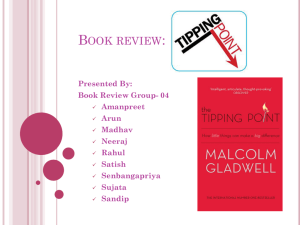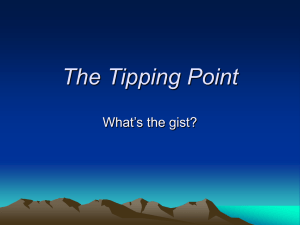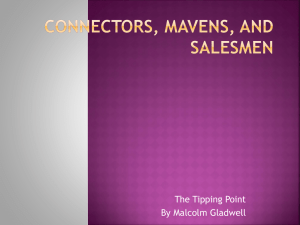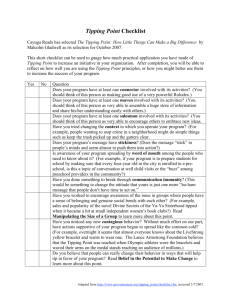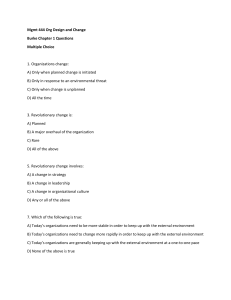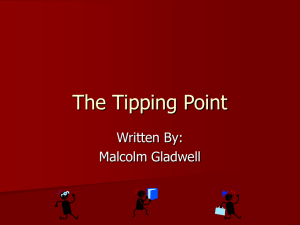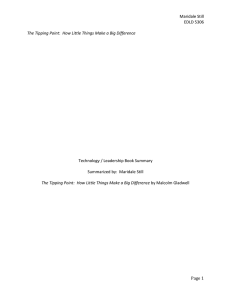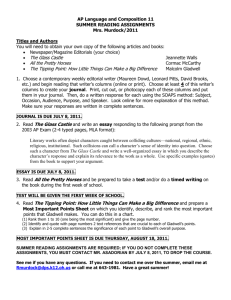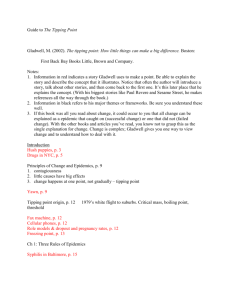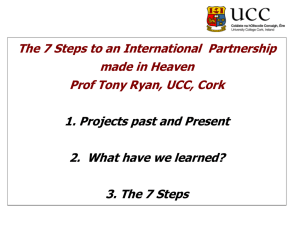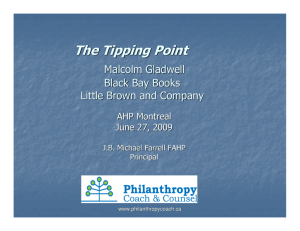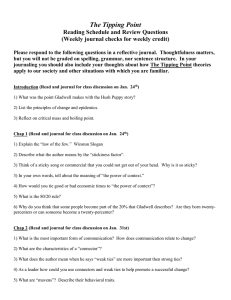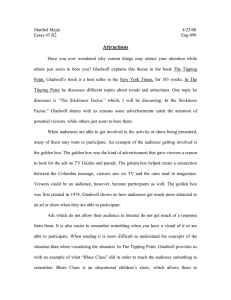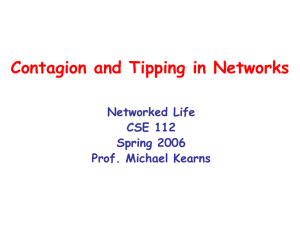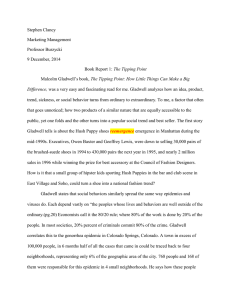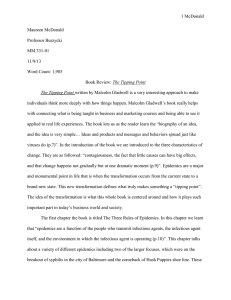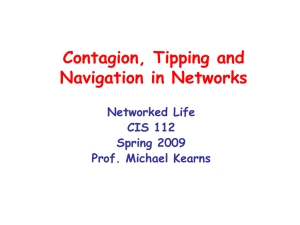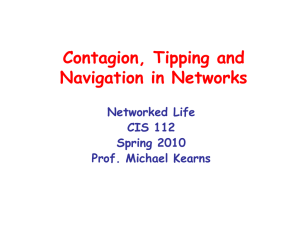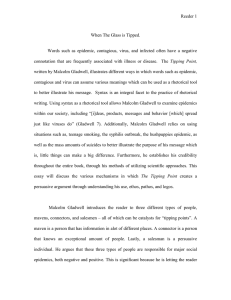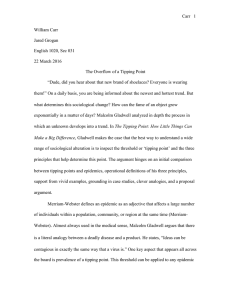Tipping Point Questions
advertisement
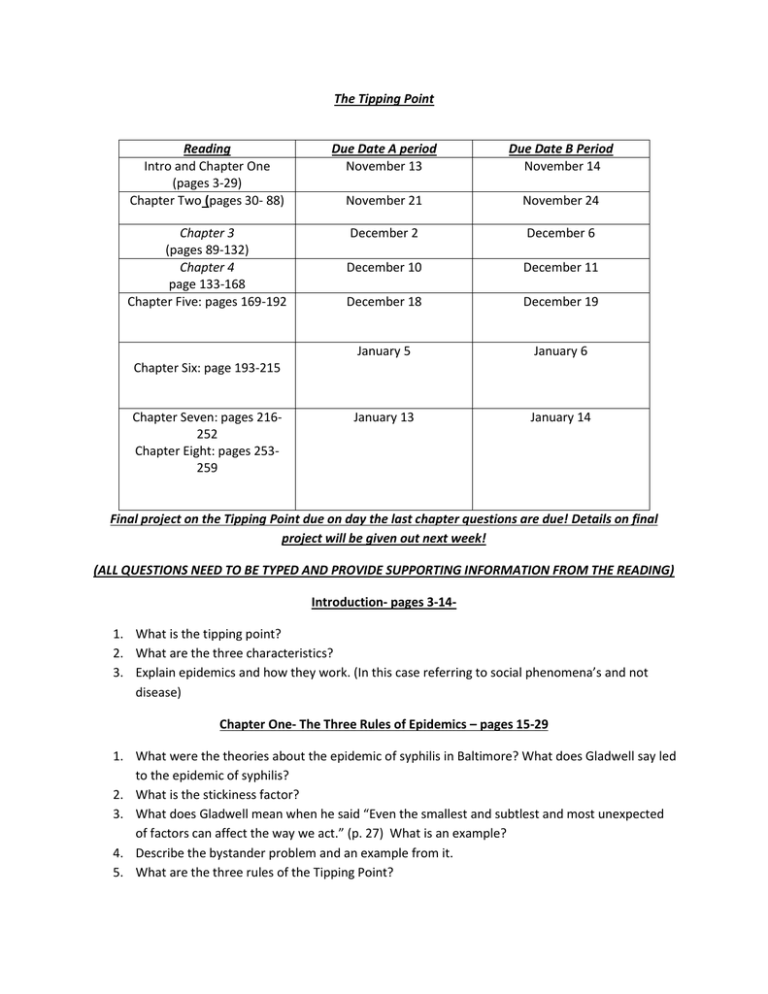
The Tipping Point Reading Intro and Chapter One (pages 3-29) Chapter Two (pages 30- 88) Due Date A period November 13 Due Date B Period November 14 November 21 November 24 Chapter 3 (pages 89-132) Chapter 4 page 133-168 Chapter Five: pages 169-192 December 2 December 6 December 10 December 11 December 18 December 19 January 5 January 6 January 13 January 14 Chapter Six: page 193-215 Chapter Seven: pages 216252 Chapter Eight: pages 253259 Final project on the Tipping Point due on day the last chapter questions are due! Details on final project will be given out next week! (ALL QUESTIONS NEED TO BE TYPED AND PROVIDE SUPPORTING INFORMATION FROM THE READING) Introduction- pages 3-141. What is the tipping point? 2. What are the three characteristics? 3. Explain epidemics and how they work. (In this case referring to social phenomena’s and not disease) Chapter One- The Three Rules of Epidemics – pages 15-29 1. What were the theories about the epidemic of syphilis in Baltimore? What does Gladwell say led to the epidemic of syphilis? 2. What is the stickiness factor? 3. What does Gladwell mean when he said “Even the smallest and subtlest and most unexpected of factors can affect the way we act.” (p. 27) What is an example? 4. Describe the bystander problem and an example from it. 5. What are the three rules of the Tipping Point? Chapter Two- pages 30- 88 1. Gladwell argues that “the word of mouth is…. still the most important form of human communication” do you agree, why or why not? 2. What are the reasons why some ideas, trends and messages “tip” and others don’t? 3. What is the law of the few? 4. What are connectors? Give an example of a connector from your life. 5. Take the test on page 39-40 and write down your number, why do you think you scored that? What does that tell you about yourself? 6. What is the six degrees of separation? 7. This chapter talks about the different worlds people live in, what different worlds do you live in? 8. Explain why Paul Revere’s midnight ride worked. 9. What is a maven? What skills does a maven have? 10. Explain the thought “They both (mavens and connectors) both have the power to spark word-ofmouth epidemics” 11. Explain the quote “The first is that little things can, apparently, make as much of a difference as big things” (page 78) 12. How are nonverbal cues as or more important than verbal cues? Chapter Three: pages 89-132 1. How did Sesame Street exemplify stickiness factor? 2. How did Blues Clues build off of the idea of Sesame Street and exemplify stickiness? Chapter Four: page 133-168 1. Describe New York City in the 1980s (include crime, conditions in subway etc) 2. Why did crime drop in New York City and other cities and how does that exemplify the Power of Context? 3. What is the Broken Windows theory? 4. Explain the quote “They are both based on the premise that an epidemic can be reversed, can be tipped, by tinkering with the smallest details of the immediate environment” (page 146) 5. Tipping Point also talks about the Stanford Prison Experiment, what does Gladwell say about the experiment in regards to this book. 6. What was the lesson learned from the “cheating” experiment? 7. What does Gladwell mean by “overestimating the importance of fundamental character traits and underestimating the importance of the situation and context” (page 160) Chapter Five: pages 169-192 1. 2. 3. 4. What is the power of context? What impact do close knot groups have on an epidemic? What impact does the neocortex have on group size and why? What is the Rule of 150? Chapter Six: page 193-215 1. Describe: a. Innovators b. Early adopters c. Early and late majority d. Laggards 2. Who is Gordon Allport? 3. What are the 3 ways Allport states that rumors are distorted? 4. Knowing that humans “repackage and reformulate” information, what does Gladwell say about the role of Mavens, Connectors, and Salespeople? 5. Explain the reason why Airwalk became popular but how it also lost customer base. 6. This chapter really closely relates the film Merchants of Cool. Discuss some of the overlapping information and the examples Gladwell uses to explain cool hunting and how it kills something that was once cool. Chapter Seven: pages 216-252 1. Why did suicides spike in Micronesia 2. How does Gladwell connect the suicides to cigarette smoking in teenagers? 3. During the time Gladwell wrote this book cigarette smoking among teens was at an all time high, now it is at an all time low. Why do you think teenagers are less likely to smoke now? Use information/ terms from Tipping Point to help explain. Chapter Eight: pages 253-259 1. What are the lessons you take away from the Tipping Point?
